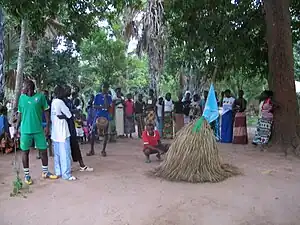Kumpo
The Kumpo is one of three traditional figures (along with Samay, and the Niasse) in the mythology of the Diola people in the Casamance (Senegal) and in Gambia.

Multiple times in the course of the year, i.e. during the Journées culturelles, a folk festival in the village is organized. The Samay invites the people of the village to participate with the festivity.
The Kumpo is dressed with palm leaves and wears a stick on his head. At the start of the dance, a young lady binds a colored flag on the stick. She dances for hours with the stick and the flag on the head. He speaks a private, secret language and communicates through an interpreter with the spectators.[1]
Social background
The Kumpo's goal is to encourage the community to act as good villagers. He encourages the people of the village to participate in community life and provides well wishes. The festival is intended as a stimulus for the social community life, and not participating to the feast is seen as anti-social behavior. The whole community is invited and there are performances of rhythmical music and dance.
According to the tradition, the Kumpo is not a person but a ghost. There is a strong relationship with the bois sacré. It is not done to ask about the real identity of the Kumpo. He may not be touched and it is considered as a sacrilege to look into the palm leaves. Therefore, he defends himself against intruders with his stick by smashing and pointing.
At the end of the feast, he says goodbye to the community and revokes into the bois sacré.[2]
Related Mythological Figures
- Videos of Kumpo in Bagaya, Senegal
- Welcoming Kumpo
- Dance of the Kumpo
- Story of the Kumpo
- Good-bye
References
- Reginald Cline-Cole، Clare Madge. Contesting Forestry in West Africa.
{{cite book}}: CS1 maint: multiple names: authors list (link) - Gina Gertrud Smith, Stanislaw Grodz. Religion, Ethnicity and Transnational Migration between West Africa and Europe. p. 115.